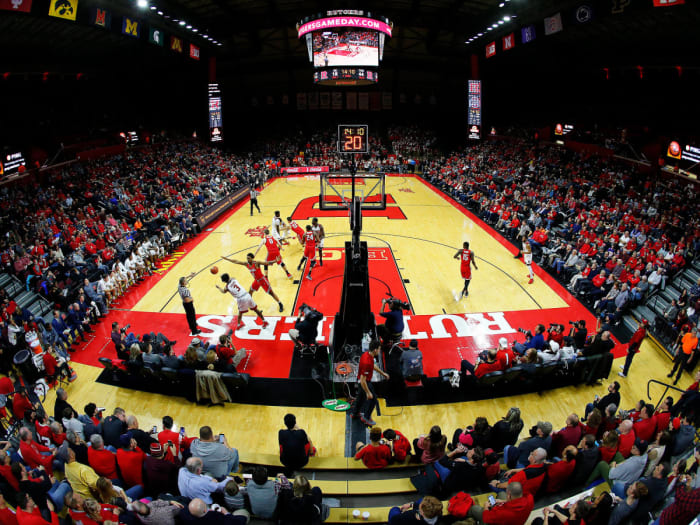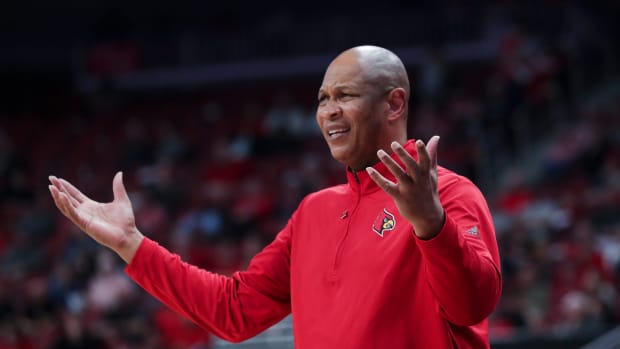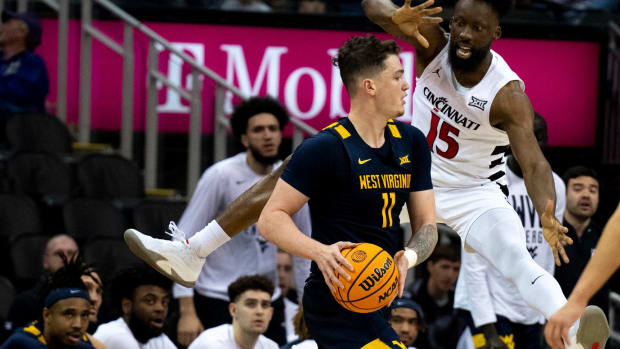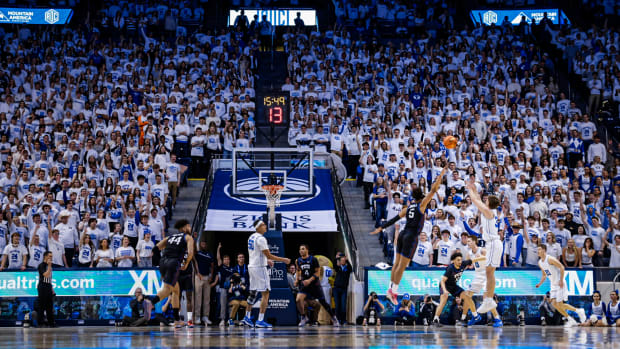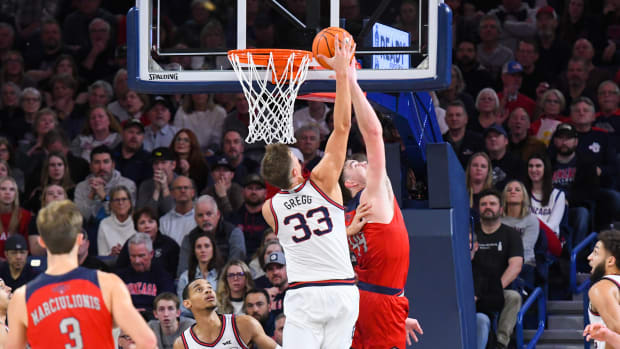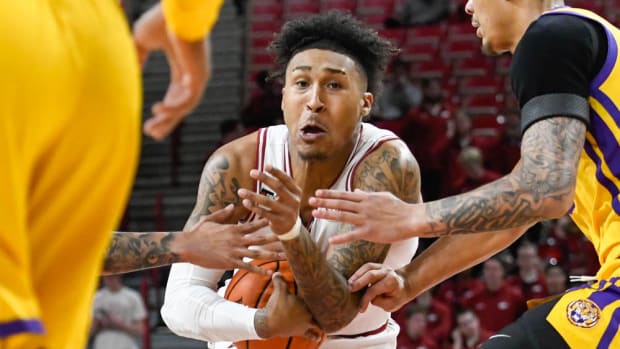How Steve Pikiell Defied the Odds and Resurrected Rutgers Basketball
PISCATAWAY, N.J. — Growing up, Steve Pikiell and his nine brothers and sisters always looked forward to the beginning of the school year. Every September, they’d each get one new pair of sneakers—and maybe a pair of pants—from their parents. That was it for the year, except for one Christmas present. Things are earned, not given, the kids learned early. If Pikiell or one of his siblings wanted anything else, they could get a job and pay for it themselves. Pikiell, the seventh youngest, mowed the lawn and had a paper route.
Pikiell took exceptional care of his shoes and one year kept them so clean that the next fall when he was gifted his annual new pair, he had two. Pikiell was thrilled—now he could wear one to school and the other to basketball practice. This was the theme of Pikiell’s childhood in blue-collar Bristol, Conn. Be regimented, set goals, work hard. So it comes as no surprise that Pikiell, 52, became a man who welcomes a good challenge. He’s made a career of turning despondent basketball programs into winners. Or as Rutgers athletic director Pat Hobbs says, “He goes from worst to first.”
Pikiell’s current project is turning the perennial downtrodden Rutgers men's basketball team into a success story. The Scarlet Knights are currently 16-5, 15-0 at home, and ranked for the first time since 1979, or as Pikiell jokes, “the first time in 100 years.” After a recent 70-63 win over Purdue, a program Rutgers had previously gone 0-8 against since joining the Big Ten in 2014, Boilermakers coach Matt Painter said, “I think they’re going to be a real tough out in the NCAA tournament.” A tough out in the NCAA tournament? Rutgers hasn’t earned a bid since 1991.
But that’s where we are. Rutgers is relevant, not embarrassing. Fans are flocking to the RAC—the 8,000-seat arena that will sell out a record 10 times this season. And the main reason is Pikiell—a likeable, relatable, blue-collar guy who accepted the head coaching job on a handshake at a New York City diner.
***
In March 2016, Hobbs met Pikiell in a booth at the Tick Tock diner across the street from Madison Square Garden. It was their first in-person meeting days after Pikiell had led Stony Brook to an America East championship and a first-ever NCAA tournament appearance. Rutgers, meanwhile, was coming off a 7-25 season under famed alum Eddie Jordan in which it went 1-17 in the Big Ten and was on a 32-game league losing streak dating back to the previous year.
Pikiell had the upper hand. His family was happy and he loved his job at Stony Brook. The university had recently built a new basketball facility, most of the team was coming back and he was close friends with university president Sam Stanley (now at Michigan State), who he played pickup with once a month. His success had been noticed, though, and programs were coming after him. Interested in furthering his career, Pikiell ran each opportunity by his mentor and former college coach at UConn Jim Calhoun, who encouraged him to consider Rutgers. Calhoun said it was an opportunity to mold a program in his image and the RAC was the toughest place he ever had to play. “I’m like, really? Of all the places you’ve been?” Pikiell says of their conversation.
Hobbs liked Pikiell because he wasn’t afraid of hard jobs and this was going to be a “monstrous effort.” He couldn’t sell him on facilities, because Rutgers hadn’t built a new athletic building in 40 years. He couldn’t dangle championships, because Rutgers had never won one. And he couldn’t lure him on historical equity, because well, it was Rutgers. But therein lied the opportunity.
Pikiell was a member of Calhoun’s first recruiting class at UConn in 1986. “At the time, people thought UConn was Yukon, Alaska,” Pikiell says. “We even had the Husky dog [mascot].” In Pikiell’s freshman year the Huskies went 4-12 in the Big East, but by his junior year they’d won the conference and made it to the Elite Eight. He stayed on post-graduation as an assistant for Calhoun and later contributed to program overhauls at Central Connecticut and George Washington before landing his first head coaching gig at Stony Brook in 2005. The Seawolves never had a winning season in Division I or won the America East, and they certainly hadn’t made an NCAA tournament, much less the NIT. “I’ve never taken a sexy job, like the schools with the names,” Pikiell says. “I had to get jobs that needed help.” In 11 seasons on Long Island, Pikiell became the winningest coach in program history, compiling a 192-155 record, which included an NCAA first-round debut against Kentucky in his final year.
Back at the Tick Tock diner, Pikiell famously told Hobbs that he’d walk the New Jersey turnpike if that’s what it took to get the job. And at that moment, Hobbs excused himself to call the board president and get permission to offer Pikiell on the spot. Even though he still had other interviews lined up, including one the next morning, Pikiell accepted without stepping foot on the Rutgers campus.
***
Waiting for him was a program perhaps requiring more help than he initially envisioned. The grungy and smelly RAC, which looks like a number of things from a weird-shaped bomb shelter to a Tatooine cave, was “neglected without a game plan,” Pikiell says. The place had no air conditioning and was impossible to schedule workouts because it was home not only to men’s and women’s basketball, but also wrestling, gymnastics, baseball, softball, cheer and dance, not to mention graduations and career fairs. There was a tutoring space too, if you could call it that—upstairs near the administrative offices sat a small table with two chairs.
When recruits visited, Pikiell had to figure out ways for them not to see too much. “They’d be like, ‘Let’s check out the weight room,’ and I’d be like, ‘Let’s meet with the academic counselor,’ hoping they’d forget.”
Now, Pikiell has a state-of-the-art, $117 million facility to show off. The RWJBarnabas Health Athletic Performance Center, which opened last September, is a sleek and modern building filled with natural light. Men’s and women’s basketball, wrestling and gymnastics all have new practice gyms, a weight room and kitchen where athletes recently enjoyed make-your-own burrito bowls for lunch. Hobbs says that when he brought the gymnastics team in to show them their new digs, complete with a Peloton bike, everyone cried. They’d previously been changing in public bathrooms to get ready for practice.
The new facility is an example of the university’s commitment to change and just a taste of what’s to come as part of the first phase of the Big Ten Build, a campaign Hobbs launched to raise $100 million for new or upgraded athletic facilities. Still on the docket are upgrades to the RAC and SHI Stadium, as well as the Gary and Barbara Rodkin Academic Success Center, which will also house the soccer and lacrosse teams and is expected to open in December. Hobbs says alumni gifts are at a record high.
Sparkly new facilities are nice, but Pikiell still had to put a product on the floor and get people to show up. He told the marketing department he’d do anything and did, from handing out pizza at fraternity houses, to grilling beef and cheese sandwiches in a food truck, to helping students move into dorms. “The deal was, we move you in and lift the heavy stuff, but you have to come to a basketball game,” Pikiell says. “Just one.”
Eventually one person would bring a friend, who’d bring their friends. Myles Johnson, the 6’11” sophomore center, has seen his engineering classmates at games and Pikiell’s neighbor bought season tickets. Now the RAC is a raucous homecourt fortress, a place students call the “Trapezoid of Terror.” Pikiell’s team is undefeated at home and junior guard Geo Baker says players want to protect the RAC. “It’s a different decibel level,” Hobbs says. “It’s become part of the thing: fans come to scream and yell and support their team.”
It helps that Pikiell has put together a team that’s fun to watch and is reflective of his identity. He says they’re “tough and grizzled” not “sexy and shiny.” They’re running and dunking and wowing with alley-oops. They pick up full court on defense, too, where they’re ranked top 20 nationally in field-goal percentage defense (allowing opponents to shoot just 37.6%) and scoring defense (giving up 60.8 points per game). They’re currently ranked third in the Big Ten after being picked to finish 12th, earning unexpected positive feedback via text messages from Tom Izzo.
It’s a far cry from where Rutgers was four years ago. Then Pikiell could entice recruits with playing time, but he doesn’t have much to go around anymore with four sophomore starters. One of them is Baker, an overlooked and underrated prospect from New Hampshire who Pikiell found while still at Stony Brook. Baker only knew of Rutgers because of former coach Mike Rice, who was fired in 2013 after videotapes showed abusive behavior toward players.
“If Coach Pikiell had told a big recruit that in three years we’d be 15-0 at home, he’d look at him and laugh,” Baker says. “But he found an underdog, chip-on-his-shoulder kid from New Hampshire who believed in that and stuck by his side. We built this thing from the ground up—literally, we were at the bottom of the Big Ten. And this is only the beginning.”
Pikiell recalls how out of sync the team had been when he first arrived. They were out of shape, gave up on drills and never hung out in the locker room. “They’d shower and leave,” Pikiell says. “The place was a dump and the culture was like, wow.” Camaraderie grew when players moved into nicer housing across the street from the RAC, got a locker room with TVs and games, and had 24-hour access to their new practice facility where they shoot around at 2 or 3 in the morning.
This season's best player is 6’6” forward Ron Harper Jr., whose father won five NBA titles with the Bulls and Lakers. He leads the team in scoring (12.0 points per game) and is second in rebounding (5.9). Six other players average at least 7.1 points per game, a testament to the team’s selflessness and budding chemistry.
***
Pikiell’s office is pretty bare. The new basketball facility only opened in the fall and he hasn’t had a free moment to decorate. There’s a flat screen on one wall that he wants to move and an old photo of him and Calhoun that he needs to hang. He’s also waiting to install three shelves that he hopes to fill with balls and trophies from future NCAA tournament runs.
“We have a firm belief that we’re going to win championships,” says Hobbs, a basketball junkie who watches film on his own after every game. “Many championships.”
The first step is finishing out this season, which continues Saturday at Madison Square Garden against Michigan. While the Wolverines may be struggling this year under first-year head coach Juwan Howard, Rutgers has never beaten them since joining the league. The Scarlet Knights also still have three ranked conference opponents left on the schedule, including No. 15 Maryland twice. That’s before playing in the Big Ten tournament and, they pray, earning a spot in the NCAA tournament.
“It would mean everything,” Baker says of a NCAA berth. “I mean, we all grew up dreaming of something like that. Just to make history at Rutgers. It’s been so long. We have the right group of guys and the right mindset to be special.”
It won’t be easy down the final stretch, but it never has been for Pikiell. And that’s just how he likes it.

